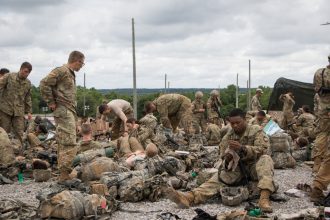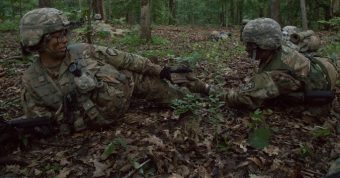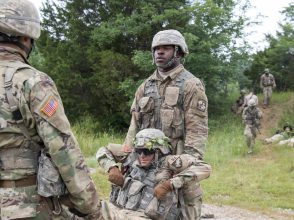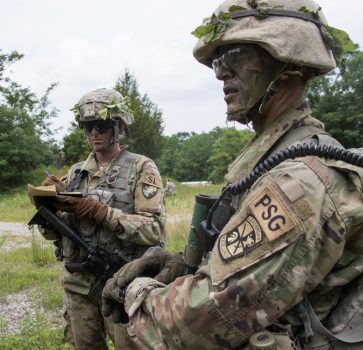
United States Military Academy at West Point Cadets and Army ROTC Cadets refit at Tactical Assembly Area Densberger during 1st Regiment’s transition to the Run Phase of the Field Training Exercise (FTX) portion of camp. | Photo by Makayla Holder, CST Public Affairs Office
Forty United States Military Academy (USMA) Cadets arrived at Fort Knox, Kentucky to join the hundreds of Reserve Officers’ Training Corps (ROTC) Cadets of 1st Regiment earlier this month.
The West Point Cadets trudged through a heavy rainstorm upon arrival, adding to the apprehension of spending two weeks alongside 1st Regiment for the Field Training Exercise (FTX) portion of Advanced Camp.
The ROTC Cadets had already spent over two weeks at Cadet Summer Training (CST) working and training together. For the first time in history, USMA at West Point Cadets were integrated with those ROTC Cadets during Advanced Camp. The 40 West Point Cadets were evenly separated into various squads of 1st Regiment.
Michael Hudgins, an ROTC Cadet attending Tarleton State University, described how well the West Point Cadets joined his platoon under the circumstances.
“When they came in, we had already been here for two and a half weeks making standard operating procedures for our platoon and integrating as a platoon,” Hudgins said. “And they got here right at the very beginning of the field exercise, and it was really almost seamless how well they integrated in with all of us. So, that was good to see.”

An Army ROTC Cadet hands an United States Military Academy at West Point Cadet a magazine while they are under fire during 1st Regiment’s Cadet-led Run Phase of the Field Training Exercise (FTX) portion of camp. | Photo by Makayla Holder, CST Public Affairs Office
Typically, students at USMA are immersed in U.S. Army training events and classes throughout their time in college. As part of a 4-year program, West Point Cadets become a second lieutenant upon graduating.
ROTC Cadets, however, attend universities across the country. They have a more typical college experience, with occasional U.S. Army training events and classes through their ROTC program. For a common training experience, the ROTC Cadets travel to Fort Knox during the summer after their third year in college. This allows for a large-scale, shared training event to prepare them for becoming an Officer in the U.S. Army.
Major Juan Renaud, Officer in Charge of Plans and Operations for CST, described the purpose of combining the two commissioning sources for training.

Cadets carry an injured squad mate to safer ground during 1st Regiment’s Walk Phase of the Field Training Exercise (FTX) portion of camp.| Photo by Makayla Holder, CST Public Affairs Office
“We started this planning process in October of last year with a few of us going up to West Point and participating in a working group, trying to figure out how to best achieve a cooperation or a combined experience between West Point Cadets and Army ROTC Cadets,” Renaud said. “So, the decision was made that we would do a pilot and that pilot would be with 40 West Point Cadets coming in to participate in a Field Training Exercise with Advanced Camp ROTC Cadets.”
The West Point Cadets only participated in FTX while at Fort Knox. Together, the ROTC and West Point Cadets implemented strategies to accomplish their missions in the field. All the Cadets worked cooperatively to complete the crawl, walk and run phases of FTX.
Dion Perinon, a West Point Cadet, said he enjoyed training with people of different backgrounds.
“It’s different in terms of the broad range of talents that people have – and the eclectic group,” Perinon said. “At West Point, there’s kind of a personality type that you’re used to training with your whole four years. But here, it’s like every single person you’re talking to is from a different part of the United States. One guy in my squad has three children and is 33 years old. Another person is a grad school student. It’s awesome interacting with all of them and getting to train with people that we will see later on in our career.”
According to Brig. Gen. Antonio V. Munera, the Deputy Commanding General of U.S. Army Cadet Command and Commandant, Cadet Summer Training, the pilot program of the West Point consolidation was very successful.

University of Maine student, Army ROTC Cadet Thomas Krause (right) gives information to United States Military Academy at West Point Cadet Megan Gould (left) as well as others during 1st Regiment’s Walk Phase of the Field Training Exercise (FTX) portion of camp. | Photo by Makayla Holder, CST Public Affairs Office
“I’m absolutely ecstatic with how it went,” Munera said. “The integration went very well both to the ROTC Cadets and the West Point Cadets. They were able to come here and both integrate very quickly. When I went out there and watched them, you couldn’t tell who was an ROTC Cadet and who was a West Point Cadet. They were all getting after the problem at hand and working together to accomplish it.”
Although there are a few interactions between USMA and ROTC Cadets each year, the Cadets are mainly disconnected from each other until they arrive at their Basic Officer Leaders Course. This integration at FTX has given both West Point and ROTC Cadets the opportunity to work as a team before commissioning as an Officer.
Next summer, there are plans for as many as 380 West Point Cadets to integrate into Advanced Camp, assigned in the first three regiments. In 2021, the goal is to have about 1,000 West Point Cadets join ROTC Cadets at CST. This way, they will receive a common experience before commissioning.




